Union Pacific vs. CSX Earnings: How Do They Stack Up?

A quick look at the stock charts of railroads Union Pacific Corporation (NYSE: UNP) and CSX Corporation (NASDAQ: CSX) would suggest the latter had a much weakerfourth quarter than its peer, but that doesn't tell the whole story. In truth, CSX's startling gain on the week is largely due to the news that Canadian Pacific Railway Limited (NYSE: CP) CEO Hunter Harrison was leaving the company in order to join activist investorPaul Hilal with an aim of taking action with CSX -- a railroad Canadian Pacific is believed to have sought to take over previously. While Harrison's move has sent the stock soaring, it's an investor's role to keep a clear head and look at the details in the quarter and compare them with the competition's results. So here goes.
Operating ratio
Until this past week, CSX and Union Pacific were closely aligned in terms of valuations. However, there are a few differences in operating metrics. For example, Union Pacific has decoupled from CSX in recent years and now sports a higher operating income margin andhigher return on invested capital.
CSX Operating Margin (TTM) data by YCharts
Controlling operating expenses is a key part of managing a railroad, and on this front both railroads had a good quarter. Railroads disclose a metric called the operating ratio. Don't panic if it sounds unfamiliar -- it's simply operating expenses divided by revenue. In other words, it's one minus operating income margin.
Both companies improved their operating ratio in the fourth quarter, with CSX's declining to 66.9% from 71.6% in the same period last year while Union Pacific's declined to 62% from 63.2%. These numbers suggest both companies are doing a good job of controlling costs in a difficult environment.
Volumes
Cost control is one thing, but railroads also need revenue growth, and that comes mainly from carload volume growth and pricing. Let's start by looking at volumes. Investors had cause to believe that volumes could improve thanks to the positive commentarygiven in December by both management teams.
Both railroads reported like-for-like volume declines, but the good news is there was a sequential improvement in both cases. For example, Union Pacific's volume fell 3% in the quarter, compared to a 6% decline in the third quarter. In addition, the 3% volume decline in the quarter is better than the decline of 4% to Nov. 25that was outlined by CFO Rob Knight at a Credit Suisse conference in December.
Image source: Union Pacific Corporation
There was a similar improvement at CSX, whose like-for-like volume declined 1% in the quarter -- incidentally, this year's fourth quarter contained an extra week, so reported volume growth was 5% -- compared to an 8% decline in the third quarter. The 1% decline is also at the high end of the low-to-mid-single-digit decline that CSX's CFO, Frank Lonegro,guided toward, also at the Credit Suisse conference.
In short, both companies saw sequential improvement in volume performance, and conditions seem to have improved through the quarter.
Core pricing
In a yet another sign of underlying improvement, both companies reported core pricing increases, with Union Pacific's core pricing increasing 1%. Meanwhile, CSX CFO Lonegro reported on the earnings call, "We continue to deliver strong core pricing from an improved service product. Same-store sales pricing for the fourth quarter was up 2.8% overall and 3.2% excluding coal."
Performance by segment and outlooks
The following charts show each railroad's volume performance by segment in the fourth quarter. Starting with CSX:
Source: CSX Corporation. Chart by author
And now Union Pacific:
Source: Union pacific Corporation. Chart by author
It's a mixed performance, but broadly speaking, both companies have positive outlooks for 2017. For the first quarter CSX sees 29% of its volume in favorable territory (most notably agriculture, automotive, fertilizers, and minerals) with 49% neutral (forest products and intermodal) and the remaining 22% unfavorable (chemicals and domestic coal).
Meanwhile, Union Pacific sees strength in 2017 from " agricultural products, coal and industrial products." according to Chief Marketing Officer Beth Whited on the earnings call.
As you can see below, the coal market remains weak on a historical basis, but some very weak numbers in 2016 means 2017 has a pretty low hurdle to overcome. Indeed, excluding the effects of a competitive loss CSX's Lonegro expects "domestic coal tonnage to be roughly flat to 2016"--not quite as good as Union Pacific, but still an indication the coal market is turning.
US Coal Rail Traffic data by YCharts
Looking ahead
Both companies continue to manage costs well, and volume trends are showing some relative improvement. Core pricing remains positive, and if the industrial economy picks up as expected, then both companies should have a better year in 2017. It's hard to pick a winner based on earnings, but if I absolutely had to do so, I would go with Union Pacific due to management's expectationfor highercoal volume in the first half of 2017.A recovery in the sector hasbeen a long time coming, but the fourth-quarter reports from Union Pacific and CSX suggestconditions will turn positivethis year.
10 stocks we like better than Union Pacific When investing geniuses David and Tom Gardner have a stock tip, it can pay to listen. After all, the newsletter they have run for over a decade, Motley Fool Stock Advisor, has tripled the market.*
David and Tom just revealed what they believe are the 10 best stocks for investors to buy right now... and Union Pacific wasn't one of them! That's right -- they think these 10 stocks are even better buys.
Click here to learn about these picks!
*Stock Advisor returns as of January 4, 2017
Lee Samaha has no position in any stocks mentioned. The Motley Fool recommends CSX. The Motley Fool has a disclosure policy.